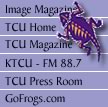 |
Who
are the people in your network neighborhood? In this computer literate age, there is still something that perplexes many TCU students. What is a Network Neighborhood? Consequently, the “My Network Places” icon remains untouched on desktops all over campus. “I don’t know what it is to begin with,” said Betsy Cunningham, a freshman business major. “I have never heard of anything like it before.” Cunningham’s
response is not an unusual one. Many TCU students are unaware of
the benefits, or even the existence, of a campus network neighborhood.
What is it? A Network Neighborhood is a computerized network of TCU students who can share different kinds of files. Students can use network neighborhood to share files with the whole campus or to share a printer with roommates. “There are over 5,000 computers connected on the TCU network, all have some capability to share files if they want to,” said Bill Senter, manager of Technical Services. However, the exact number of students participating in file sharing is unknown. The
good and the bad Amie Street, a junior neuroscience major, said she uses the network mostly to share music files with her roommates and friends. “It’s the fastest way to get songs and it’s the easiest way,” Street said. Sharing files is not only faster, but it allows you to browse music files without searching for anything specific. “If you can go to another person’s computer, and (find songs you’ve never thought of) you can try out new music and songs you might not have thought to look for,” Street said. “It’s a lot easier to transfer over the network than it is to download from someone’s computer miles away.” However, file sharing is not perfect. It can slow down your computer if too many people are sharing your files at once. This can be prevented by restricting access with a password, which allows sharing only by people who have the password. File sharing can also be used for classes, to share files and notes with others in a class. “Sometimes the premeds will post some kind of notes or answers or something on somebody’s computer and then you can access them freely,” said Street. Keep in mind however, that sharing goes both ways. One can get files from other people, but they can also access your files. For reasons of confidentiality, some might choose not to participate in file sharing. “I discourage people from using the network unless they are working on a project for class,” said Dick Rinewalt, chairman of the computer science department. “If you have file sharing set up as read-only then you are not vulnerable to viruses. However, you might accidentally share something you didn’t intend to share.” “Network neighborhood is not something you actually have to ‘set up’,” said Senter. “Once you are on the network you will be part of a Network Neighborhood.” After a student activates his or her on-campus account, a network folder is created for them and placed in their residence hall’s folder. However, a student must choose to allow their computer to share files with others on the network. “When some people put what dorm they’re in, they don’t spell it right,” said Angela Hutchinson, a senior marketing major. “So there’ll be five Sherleys and five Miltons. It can be really hard to find stuff sometimes cause people don’t know how to spell.” Spelling errors aside, the network also has some other problems. One of which is organization. “It’s not organized whatsoever... there is no system,” Chris Mattingly, a sophomore business major, said. “Unless you know where you are going or who you are looking for, then you could be stumbling through a number of empty folders, and it would just take up time. You might be able to find something, but you might also find stuff you don’t need or stuff you don’t even want to find.” Legal
Implications Students who use Macintosh computers can also participate in file sharing, but only with other Mac users on a separate network. “Macs do not currently log into a Windows domain in the faculty/staff network,” Senter said. “We do not offer as many network file services to Mac systems as we do to Windows systems.” To find out in detail how to set up network sharing, Kim Weber, manager of User Services, said she recommends contacting the Information Commons Desk in the Library.
Story
by Jessica Sanders |
|
|
TCU Daily Skiff © 2002 |
||



